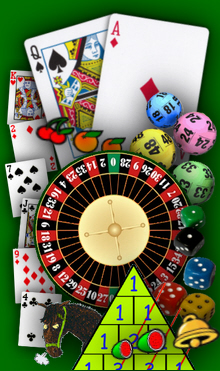|
|
|
How To Play
Any number of people can play against the Banker.
Suppose you bet $1 on all six symbols, and the dice land showing three different symbols, you'll receive 3 x $2 =$6 back. Nobody wins or loses! And if two matching dice pay double, and three dice pay treble, surely it all nicely evens out? Actually, it isn't quite as simple as that. |
|
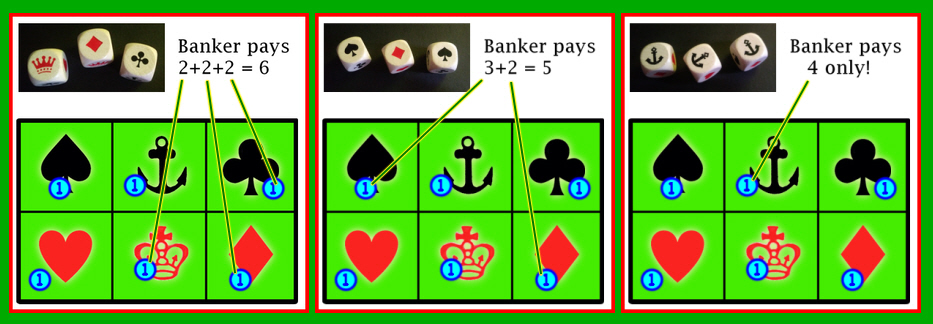
|
|
The Banker makes his profit when a double or treble appears, but what proportion of singles/double/trebles can he expect? To work out these chances, we imagine the three dice landing one at a time.
For a treble, the first dice can be anything. The second has a 1/6 chance of matching and the third also has a 1/6 chance of matching. The chance of a treble is 1 x 1/6 x 1/6 = 1/36. He pays back $4 on trebles so his expected payout is 4 x 1/36 = $0.11111 For a double the sums are slightly more complex but there's a nifty short cut. We know the singles chances are 20/36 and the treble chances are 1/36, and all the remaining throws must be doubles, so the chances are 1-20/36 -1/36 = 15/36. He pays back $5 on doubles so so his expected payout is 5 x 15/36 = $2.083333 In total, for every $6 the banker receives, the expected payout is $3.33333 + $2.083333 + $0.11111 = $5.527777. Therefore his profit is $6 - $5.52777 = $0.472223. The banker's percentage profit is 0.472223 / 6 = 7.87% So for every $100 bet, the banker can expect to make almost $8 in profit. This is a far better game for the banker than roulette, blackjack or most of the bets on craps. |
|
|
|
|
Blackjack - Hit, Stand, Double Down or Split?
Craps - How to place, Chances and Payouts
The Betting Guide - and how to work out the Bookie's profit!
The Roulette Wheel ... and how to worry the casino!
The One-Armed Bandit Slot Machine
|
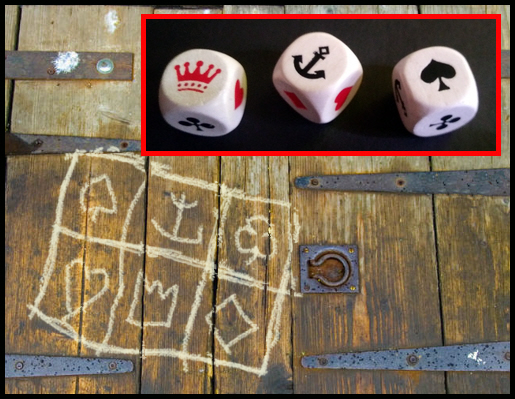 The Sailor's Game
The Sailor's Game Players bet on one or more symbols by putting coins or chips on the play mat.
Players bet on one or more symbols by putting coins or chips on the play mat.  The Banker's Edge
The Banker's Edge 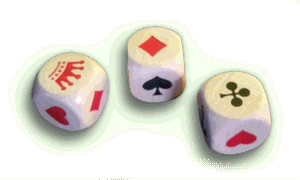 For a single (i.e. all the dice to land differently), the first dice can be anything. The chance of the next dice being different is 5/6, and the chance of the third dice being different from the first two is 4/6. Therefore the chances of the dice all landing differently are 1 x 5/6 x 4/6 = 20/36. The Banker pays back $6 when three different dice are thrown, so his expected payout is 6 x 20/36 = $3.33333
For a single (i.e. all the dice to land differently), the first dice can be anything. The chance of the next dice being different is 5/6, and the chance of the third dice being different from the first two is 4/6. Therefore the chances of the dice all landing differently are 1 x 5/6 x 4/6 = 20/36. The Banker pays back $6 when three different dice are thrown, so his expected payout is 6 x 20/36 = $3.33333
 The Player's Chances
The Player's Chances 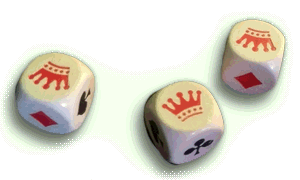 Treble The chances of the three dice all matching your symbol are 1/6 x 1/6 x 1/6 = 1/216.
Treble The chances of the three dice all matching your symbol are 1/6 x 1/6 x 1/6 = 1/216.
